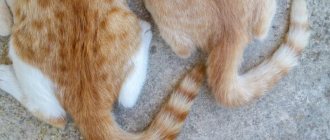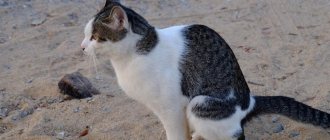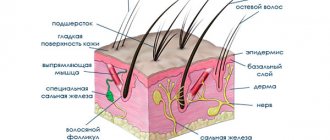When a pet gets sick, its owner falls into a real panic. This is not surprising, because the animal cannot tell what exactly hurts it and how it feels. Based on this, owners of four-legged animals have to search for information on the Internet on their own, studying similar cases, or contacting a specialist in this field.
Sometimes people are interested in the fact that the cat has a bump under its tail. Could this be a symptom of a serious illness or is it nothing to worry about?
Basically, the appearance of seals on the tail is explained by the fact that the animal may have received insufficient care, and its nutrition is not balanced. However, there are other reasons.
Bruises and injuries
If the animal often walks on the street, then a fight could easily occur between several cats. They become especially aggressive at the beginning of spring, as their most romantic period begins. Damage can also occur at the household level. For example, an animal climbed onto a cabinet and fell unsuccessfully. Sometimes pets are injured by their owners, but only through their own negligence.
If damage to the skin occurs, then an infection could enter the body in this place. This often results in abscesses that look like the cat has a lump at the base of its tail. Such a manifestation requires mandatory examination by a doctor.
Associated symptoms
Let's look at the main signs of pain near the tail:
Fracture - in this case, the position of the tail will be lowered, and any impact on your part when trying to lift it will cause pain to the animal. Wound (violation of the integrity of the coat) - scratches and abrasions can be obtained during a fight with other cats or due to the carelessness and carelessness of the animal. Hair loss can also be the reason why a cat won't allow the base of its tail to be touched due to pain. A fungal growth or infection causes these symptoms. Fear - if the cat is afraid of something or has been beaten and humiliated repeatedly, the tail will be feathered and the base will hurt
Therefore, every touch to the animal will be accompanied by loud screams and plaintive meows. Allergies can occur both to food and household items (cleaning products, perfumes). Worms - development in the body will lead to pain in various parts of the body, including at the base of the tail.
It is sometimes almost impossible to determine the diagnosis on your own; even an experienced veterinarian in such cases, without appropriate diagnostic measures, will not be able to determine the disease by eye, so you should not delay going to him.
Demodicosis
This is a fairly common reason for the appearance of a bump on a cat’s tail, which occurs in veterinary practice mainly in the warm season. In this case, we are talking about infecting a four-legged pet with a subcutaneous parasite, which is known to many as a tick.
But some people don’t even realize that it not only begins to suck blood from a helpless animal, but also leads to the development of extremely serious infectious pathologies. A tick can parasitize a cat’s body for quite a long time. Most often, pets who are allowed to walk outside suffer from this pathology. However, a person can also bring ticks on clothes into an apartment.
Diagnostic methods
After examination and collection of complaints and medical history, the specialist sends the child for a general examination . It includes x-rays, blood and urine tests . Additionally, the following studies may be needed:
- blood serology;
- diagnosis of tuberculosis;
- lymph node biopsy followed by cytological examination in the laboratory;
- Ultrasound.
Sometimes children are prescribed antibacterial drugs as part of the diagnosis. Based on their effectiveness, they confirm or refute the bacterial nature of the disease.
Cancer
Unfortunately, cancer can cause a lump to appear on a cat's tail. In this case, it is necessary to conduct a serious medical examination. Depending on the final diagnosis, appropriate treatment will be prescribed. In some situations, at the initial stage of oncology development, it is possible to fight this disease and achieve a complete cure for the animal.
However, it is very important not to delay the treatment process.
Zhiroviki
Wen (alternatively called lipoma) is a soft subcutaneous formation. It is formed as a result of the proliferation of adipose tissue. If you find one or more wen in your cat, you should contact your veterinarian. Through a biopsy, he will determine whether the growth is benign or malignant.
It is impossible to eliminate the wen with the help of drug therapy, only by using surgical intervention. However, such a measure is recommended only in cases where the formation is malignant and threatens the life and health of the cat. In such situations, in addition to surgical removal of the wen, the animal is also given courses of chemotherapy . In other cases, the wen is considered a completely harmless phenomenon and does not require removal.
Main symptoms
If a lump appears on a cat’s tail, then you need to clarify the reasons for this formation. To do this, you need to pay attention not only to the behavior of the animal, but also to the characteristics of the neoplasm itself. If the lump is soft, then in this case it is most likely to be an abscess. This is a dangerous condition.
If a cat has purulent bumps on its tail, then the animal will additionally experience an increased body temperature. Abscesses can be either only on the tail, or throughout the body. In this case, the animal will behave very restless and irritated. Especially when its owner presses on a sore spot. If a cat has a lump on its tail or other alarming signs are observed, then measures need to be taken.
If the formation is solid, then most likely it is a healed fracture of the tail bones. However, such manifestations may also indicate more serious pathologies.
If the animal suffers from the parasitic activity of a tick, then in this case it will immediately experience a number of alarming symptoms. Among them, it is worth highlighting increased body temperature, lethargy, constant apathy, lack of appetite, paleness of the mucous membranes of the eyes and mouth. It will become more difficult for the animal to move, and shortness of breath will appear.
If suspicions fall on a wen or lipoma, then, as a rule, such formations do not manifest themselves at all and remain completely invisible to the animal. The cat will allow itself to be stroked, and at the moment of touching a troublesome place, do not be nervous. As a rule, wen forms if the pet has a metabolic disorder.
Oncological pathologies are the most difficult to manifest. Cancer can remain invisible for a long time both to the owner of the four-legged pet and to himself. To identify this pathology at the very initial stage, it is necessary to periodically conduct a full medical examination of the pet.
Indicators of normal lymph nodes:
- diameter up to approximately 5 mm;
- soft consistency;
- single location, that is, lack of connection with each other or with the skin;
- absence of pain upon palpation (palpation);
- mobility.
Reasons for enlargement and main groups of lymph nodes
| Group of lymph nodes | Typical reasons for the increase |
| Parotid | Pyoderma (inflammation of the scalp accompanied by pus), inflammation of the outer or middle ear, the presence of lice, atopic dermatitis, eczema. |
| Occipital | Various inflammations in the scalp, fungal diseases, rubella, etc. |
| Submental | Abscess of the jaw, inflammation of the lower lip, damage to the front teeth, stomatitis. |
| Submandibular | Gingivitis, stomatitis, dental damage. |
| Cervical (in the direction of the muscles at the back of the neck) | Sore throat, chronic tonsillitis, tuberculosis of the tonsils, adenoids, infectious form of mononucleosis. |
| Cervical (middle) | Scarlet fever, tonsillitis, “cat scratch disease”, Hodgkin or non-Hodgkin lymphoma ( important - these are malignant oncological processes!), toxoplasmosis. |
| Cervical (lateral) | Tumors, lymph node tuberculosis, nasopharyngeal infections. |
| Elbow | Infections of the forearm or hand. |
| Axillary | Shoulder or arm infections, vaccine reactions, cat scratch disease. |
| Inguinal | Infections of the skin, bones and muscles of the lower extremities, inflammation of the joints, dermatitis, inflammatory processes in the genitals, reaction to a vaccine introduced into the femoral area. |
Features of treatment
Therapeutic measures are prescribed by the doctor depending on the specific cause that led to the appearance of a bump on the cat’s tail. To do this, you first need to undergo diagnostics and tests.
If we are talking about a purulent abscess or an early stage of cancer, then in this case the intervention of a surgeon is usually required. When a tick or wen appears on an animal’s body, surgery is not always performed. The doctor must take into account the risks depending on the age of the animal and its state of health.
If the lump appears due to a broken bone, then in this case it needs to be cleaned. This procedure is also performed by a specialist. After this, the treated area will need to be periodically lubricated with antibacterial and healing agents prescribed by the doctor. Also, after treatment, you need to give the animal rest and adjust its menu.
General information
The organs of the lymphatic system play a protective role in the human body. They serve as a barrier to viruses, bacteria, and also filter out harmful substances. In total, there are more than 450 lymph nodes in the adult body, and their maximum number is formed by the age of 10.
Lymph nodes are connected by lymphatic vessels - lymph (a fluid with a high content of lymphocytes, or “white blood cells”) circulates through them. Produced in the bone marrow, lymphocytes circulate throughout the body, first passing through the spleen and then the lymph nodes. Thanks to this, they gain the ability to produce antibodies to destroy microbes. Source: A.G. Rumyantsev, professor, V.M. Chernov, professor, V.M. Delyagin, professor Enlarged lymph node syndrome as a pediatric problem Practical Medicine, 2007, No. 5 (24), pp. 12-15
When an infection enters , a kind of “attack” is carried out on it, as a result of which the lymph nodes can enlarge (during this period they more actively produce antibodies). After recovery, the nodes return to normal size. If their diameter and density do not return to their original state, the child must be shown to a doctor.
Prevention
In order not to guess why a cat has a bump on its tail or any other formations, it is best not to let the animal go outside unnecessarily, especially in the spring. If this is not possible, and the pet still goes for walks periodically, then in this case it is recommended to purchase a special collar, the smell of which will drive away parasites.
To exclude most other problems, you need to review the animal’s diet and balance it so that the cat receives all the necessary mineral components and vitamins. However, allowing obesity is also not recommended.
Sometimes bumps of this type are congenital. They become noticeable immediately after the kitten is born. In this case, the defect does not affect the condition of the animal in any way, so there is no cause for concern. But it’s better to play it safe and rule out other pathologies.
Cleaning a cat's anal glands
Here's how to clean a cat's anal glands:
- It is necessary to stock up on disposable surgical gloves, Vaseline or vegetable oil.
- It is recommended to carry out the procedure in the bathroom, or in a basin of suitable size. The secretion released during cleaning is extremely smelly!
- It is necessary to lift the cat above the ground with your left hand, holding it by the tail. At the same time, it is necessary to pinch the inflamed glands and, gently pressing on them, remove the accumulated secretion.
- Since the released liquid is extremely smelly, we recommend that you immediately wash it off with a running shower.
Causes of subcutaneous lumps
Small round balls often appear after injection under the skin. They are called post-injection granuloma and resolve on their own a few days after the end of the injections. To avoid them, the injection site is massaged daily. Sometimes granulomas remain for life, without changing their size and position. In other cases, the reason lies in:
- blockage of the sebaceous glands;
- allergic reaction;
- infestation with parasites;
- hormonal imbalances;
- infection of open wounds;
- disturbances in the formation or functioning of connective tissues;
- injuries;
- inflammatory processes.
The risk group includes older animals, cats with chronic diseases, late castrated and sterilized pets. The risk of developing cancer increases with constant stress, low activity and poor diet. A predisposition also appears with frequent injuries in the same area of the body, infection with leukemia and regular inhalation of tobacco smoke. Cancer is often inherited and is diagnosed in animals older than 7 years.
First aid
If the damage is closed and no movement of vertebral fragments is noticeable upon palpation, then this is a good sign.
The wound should be treated with a 3% solution of hydrogen peroxide, if there is bleeding, apply a tight bandage, and the animal should be given an anesthetic, for example, ketofen. A consultation with a doctor is required, as inflammatory processes may develop.
A broken tail requires immediate veterinary attention.
Wounds, bruises, ulcers and abscesses are treated in the usual ways: surgical treatment (using peroxide, dioxidine, Levomekol ointment, Vishnevsky emulsion, etc.), prescribing a course of antibiotics and painkillers. Fractures and dislocations are reduced and fixed using a splint bandage. Contracture (limitation of mobility due to tightening of muscle fibers) is sometimes eliminated by myotomy (cutting, separating muscles) on the healthy side.
Gangrene, advanced purulent processes, complex fractures and crushed vertebrae are reasons for surgical treatment - amputation. After amputation of the tail, the cat does not feel an “inferiority complex” and continues to lead its usual lifestyle.
During treatment, the cat is put on an “Elizabethan” collar, which protects the wound from removal of the bandage and licking.
Tail ulcer
It is quite common for short-haired cats to develop ulcers on their long tails. These ulcers can reach all the way to the root of the tail, causing necrosis of the vertebrae of the caudal process. A specific disease has strict pharmacological treatment and special recommendations for treating the cat at home by the owner himself. In addition, for ulcers, treatment of the tail includes the process of clearing away dirt and crusts that have formed. Then the affected area of the tail must be treated with antiseptic powder and lubricated with a prescribed special agent, in particular, it is possible to use cubatol aerosol. Subsequently, ointment is applied to the affected and pre-treated area. Suitable here: liquid Vishnevsky liniment, syntomycin ointment or streptomycin. The treated area of the cat's tail is wrapped in a light bandage for protection for 5 days. During this time, you should regularly comb the hair in the affected area in order to prevent itching in the cat. For additional insurance during procedures, it is necessary to use a protective circle or a “pots” muzzle. If this disease is neglected, gangrene may appear, so at the slightest suspicion of an ulcer, timely measures must be taken, otherwise, in extreme cases, the tail will have to be amputated.
- Cat Tail Diseases
- Cat Tail Diseases











